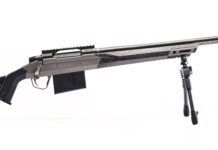Rifles set up for long-range precision shooting are specialized instruments with features that allow the user to consistency wring out accuracy at or beyond 1000 yards. We recently looked at three precision rifles in the big-boy cartridge of 300 Winchester Magnum to see what hit our wallets had to take to get in on the fun of precision rifle shooting.
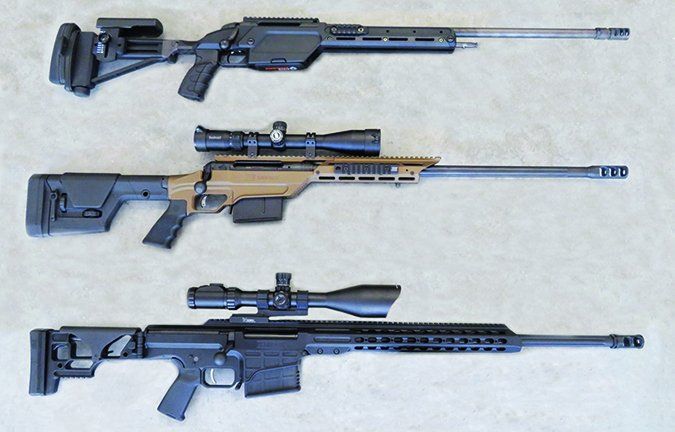
At the low end of the price range, we tested a Savage 110 BA Stealth ($1484) and two that were nearly four times the cost, a Steyr SSG 08 ($3353) and Barrett MRAD ($6000). After the dust had settled, we determined the cost of the rifle did not make much difference in its accuracy performance. All rifles grouped sub minute of angle, requiring us to measure to two decimal places, or hundredths of an inch, to determine the top gun in accuracy. Spoiler: We shot the smallest group with the Savage. What separated the low-cost 110 BA Stealth from the premium-priced Barrett and Steyr were features that made the premium rifles easier to shoot or were more adaptive to the user’s needs.
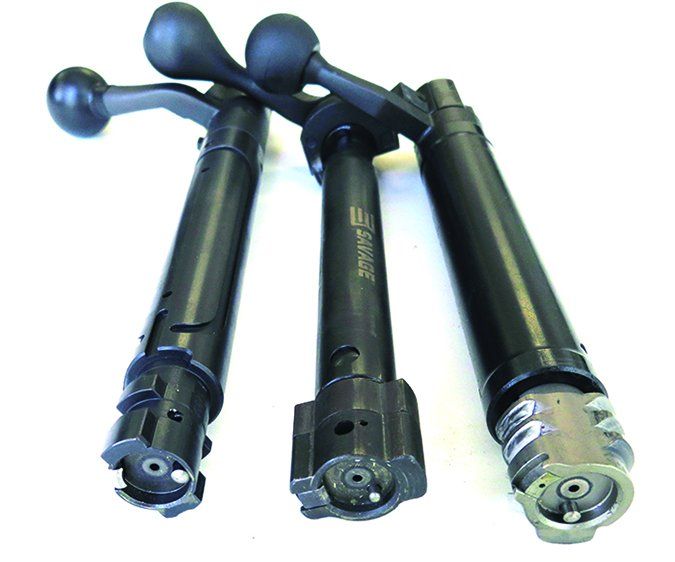
We went to MidwayUSA.com to fit the rifles with two affordable variable-power scopes and mounts. The first was a Bushnell Engage 4-16x44mm ($399) with Weaver Tactical Skeleton rings ($35). The second was a Leapers UTG Accushot 4-16x56mm scope ($245) with a Bobro 1-Piece QD mount ($235). The Engage scope uses what Bushnell calls a Deploy MOA reticle. We felt this scope offered clarity and sharpness. The locking turrets were easy to use and require no tools to adjust windage and elevation. We also liked the parallax adjustment, which we feel is a requirement for long-range shooting.
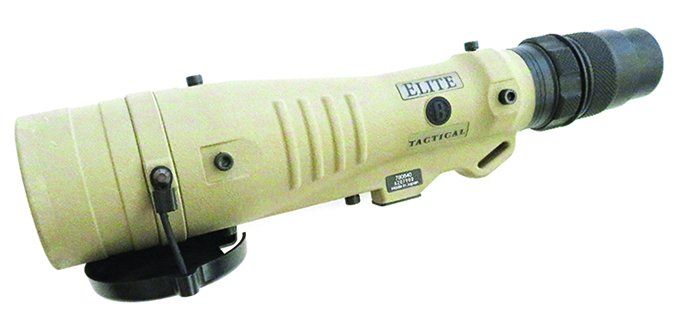
The eyepiece was also easy to adjust and allowed different testers to dial in sharpness for their individual eyes. The magnification had just the right resistance so we could be on target and adjust magnification by feel, but not have to move out of position to make the optical changes we wanted. The Weaver rings are also a low-cost option that easily dealt with the recoil of the 300 Win. Mag. Since the Weaver set up used separate rings, we were able to ensure the Bushnell was well attached to the Picatinny rail of the Savage.
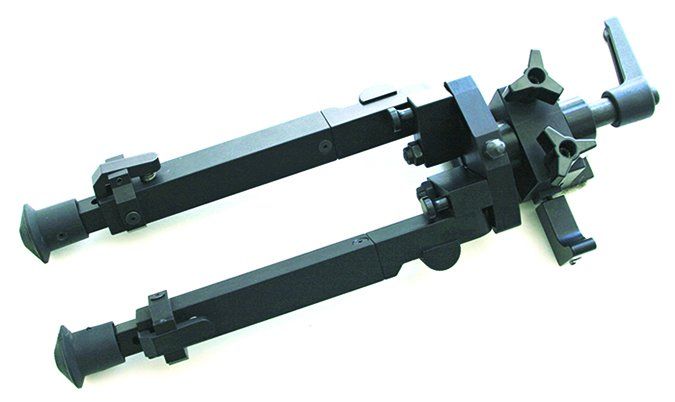
The Leapers UTG Accushot 4-16x56mm performed similarly to the Bushnell but offered an illuminated reticle in either red or green, which some testers liked. A black reticle can be more difficult to aim on a black target. It featured a mil-dot reticle with a bubble leveler, letting the user know if the rifle is canted, which could affect the shot. Both scopes featured a second-focal-plane reticle, so the magnification needs to be set on a specific magnification for the reticle to be used in range estimation. The Bushnell needs to be dial to 16x, the highest magnification, and the Leapers needs to be dialed to 10x. In our opinion, the reticles and magnification ranges were suitable for long-range work, well over the yardage found at most public shooting ranges. We were pleased at the performance of both scopes.
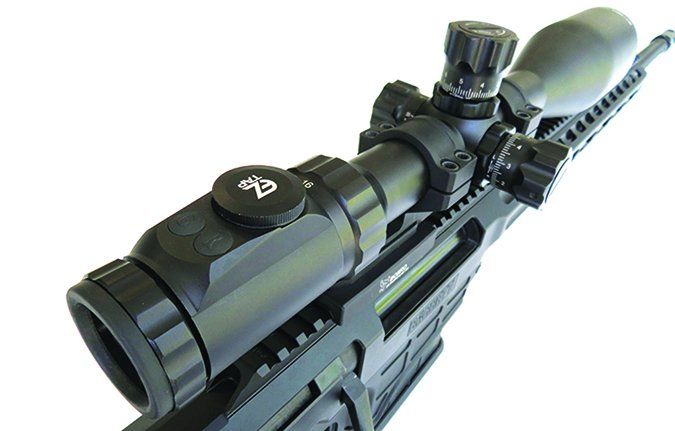
The Bobro Engineering Precision Optic Mount, Close Gap Ring with single lever QD mount was used with the Leapers scope. This mount is designed to fit to any Picatinny rail. We liked this mount a lot and have used it previously on AR rifles, and because the Barrett has a straight stock comb, it provided the correct eye height. Also, because we did not have a lot of Picatinny rail on the Steyr, it worked well on that rifle. We used this scope-mount set up on the Steyr first then placed it on the Barrett and were able to get zeroed with three rounds. We found the Bobro could take the pounding and recoil of the 300 Win. Mag. with no issues.
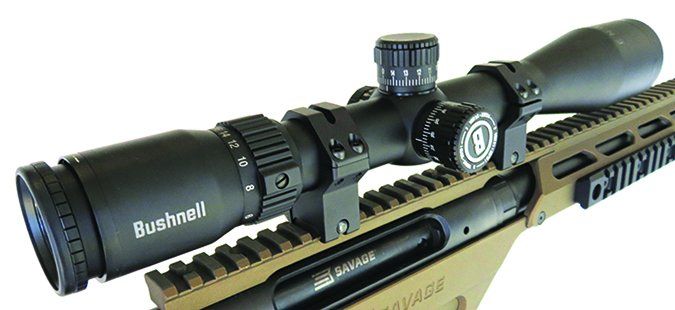
To check our work shot to shot, we used a Bushnell Tactical LMSS 8-40x 60mm spotting scope ($1300 from OpticsPlanet.com). This is a one-piece spotter without a separate eyepiece. This spotter is straight and offered plenty of focus adjustment, clarity, and an eyepiece for the user with eye glasses. We liked this spotter, though we would have liked the magnification rings to turn a bit easier. We used it with and without a tripod and could count the mirage waves floating out at 200 yards on a 95-degree day in North Carolina. We could also see black bullet holes in black bullseyes easily.
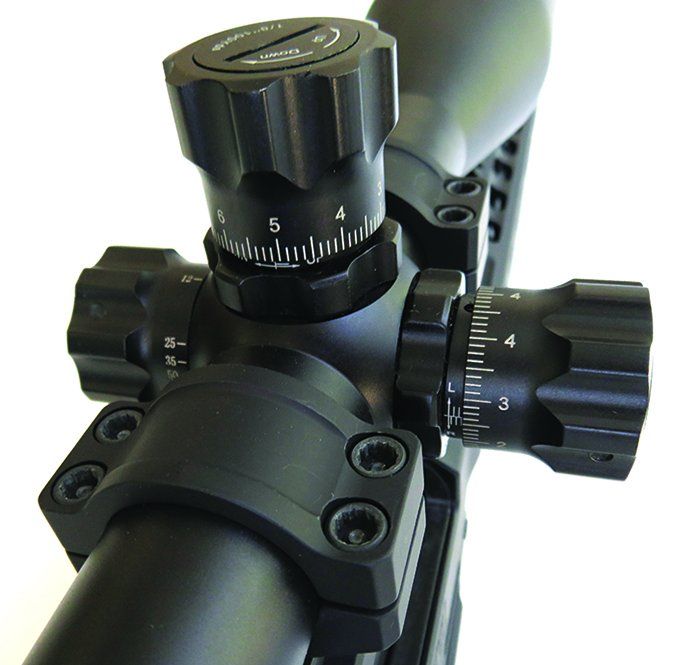
With specialized long-range equipment, you need ammunition up to the task. The hunting ammunition types we chose included Federal Premium 200-grain Edge TLR Polymer Tipped Bonded Boat Tails and Federal Ammunition Non-Typical Whitetail 180-grain Soft Points. The match-style loads were Hornady Match 178-grain ELD Polymer Tip Boat Tail bullets and Federal Premium Sierra MatchKing 190-grain Boat Tail Hollow Points.
Range Data
| Federal Premium Gold Match 190-gr. Sierra MatchKing BTHP | Barrett MRAD | Steyr SSG 08 | Savage 110 BA Stealth |
| Average velocity | 2996 fps | 2933 fps | 3009 fps |
| Muzzle energy | 3787 ft.-lbs. | 3630 ft.-lbs. | 3820 ft.-lbs. |
| Smallest group | 0.67 in. | 0.64 in. | 0.55 in. |
| Average group | 0.82 in. | 0.66 in. | 0.58 in. |
| Hornady Non-Typical Whitetail 170-gr. SP | |||
| Average velocity | 2995 fps | 2946 fps | 3026 fps |
| Muzzle energy | 3586 ft.-lbs. | 3469 ft.-lbs. | 3660 ft.-lbs. |
| Smallest group | 0.70 in. | 0.83 in. | 0.70 in. |
| Average group | 0.78 in. | 0.86 in. | 0.77 in. |
| Federal Edge TLR 200-gr. Edge TLR | |||
| Average velocity | 2949 fps | 2914 fps | 2949 fps |
| Muzzle energy | 3863 ft.-lbs. | 3772 ft.-lbs. | 3863 ft.-lbs. |
| Smallest group | 0.75 in. | 0.63 in. | 0.78 in. |
| Average group | 0.77 in. | 0.74 in. | 0.83 in. |
| Hornady Match 178-gr. ELD Match | |||
| Average velocity | 2956 fps | 2930 fps | 2996 fps |
| Muzzle energy | 3454 ft.-lbs. | 3394 ft.-lbs. | 3548 ft.-lbs. |
| Smallest group | 0.60 in. | 0.90 in. | 0.76 in. |
| Average group | 0.73 in. | 1.08 in. | 0.86 in. |
| To collect accuracy data, we fired five-shot groups from a bench using a bipod. Distance: 100 yards. We recorded velocities using a ProChrono digital chronograph set 15 feet from the muzzle. Ammo sources: 300 Winchester Magnum Federal Ammunition Non-Typical Whitetail 180-grain Soft Point 300WDT180 ($23.59/20 from CheaperThanDirt.com); 300 Winchester Magnum Hornady Match 178-grain ELD Polymer Tip Boat Tail bullet 82043 ($42/20 from CheaperThanDirt.com); 300 Winchester Magnum Federal Premium 200-grain Edge TLR Polymer Tipped Bonded Boat Tail P300WETLR200 ($40/20 from MidwayUSA.com); and 300 Winchester Magnum Federal Premium Sierra MatchKing 190-grain Boat Tail Hollow Point GM300WM ($40/20 from MidwayUSA.com). | |||
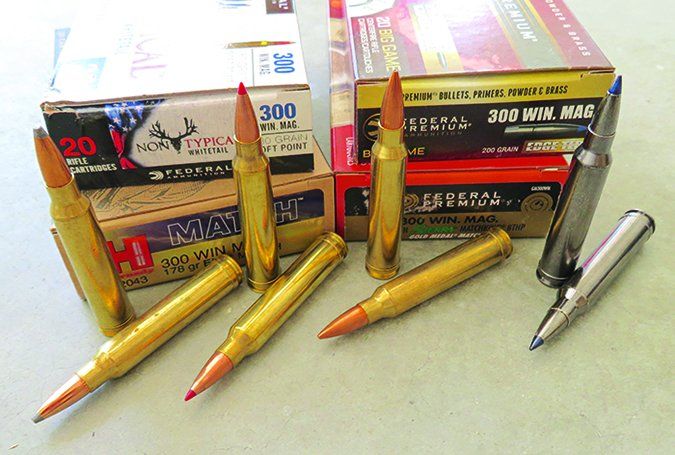
How We Tested
We test-fired the rifles using a bipod. The Steyr came with a bipod, and we had on hand a Sinclair Tactical Bipod ($199 from Brownells.com), which attaches to a sling swivel stud. We fired sitting at a bench and in the prone position at target sets at 100 and 200 yards. It was 95 degrees during testing, so it did not take many rounds down the tube to heat up the barrel.
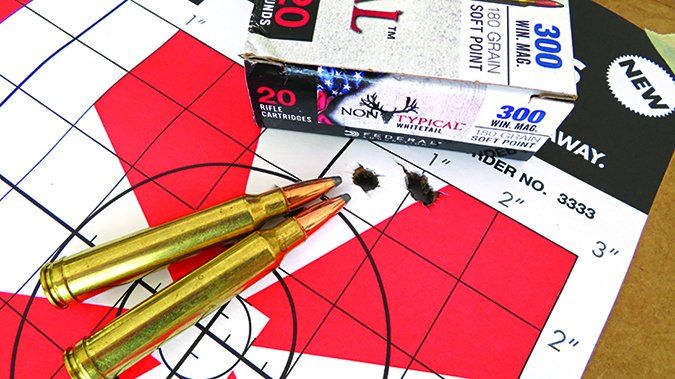
Our firing sequence consisted of five shots, swap rifles to allow the barrel to cool, and repeat the process until all rifles fired all four ammo types for accuracy and chrono results. We then loaded up the magazines and cranked through rounds as fast as we could to see how a hot barrel might impact accuracy.
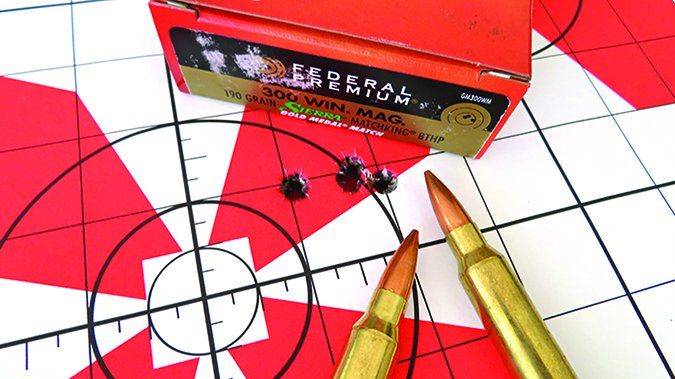
These are heavy rifles, and that is a good feature in a long-range rifle. The weight helps settle the rifle, especially when your heart beat can cause the reticle to move when aiming. This is especially true when you have three bullet holes clustered together so close it looks like one hole and you have two more shots to make. Self-imposed pressure for sure. The weight also helps stifle the recoil of the 300 Win. Mag. To help with recoil further, the rifles featured beefy muzzle brakes.
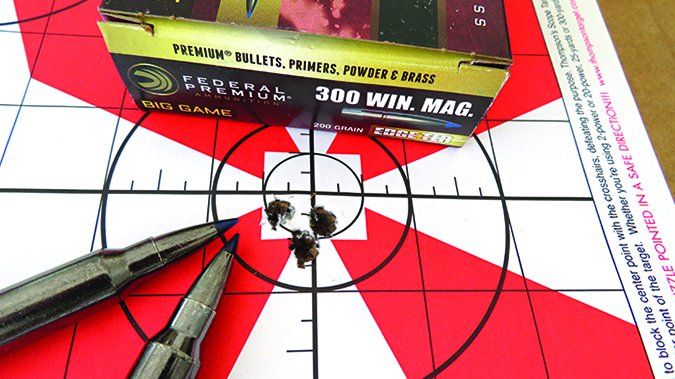
We collected data at 100 yards and also fired at 200 yards, anticipating groups opening up, which they did. What these rifles do is help build confidence so 200 yards is a chip shot. If we did our part, the rifles would do our bidding with surgical consistency. We would like to own any of the rifles tested, but some testers leaned more toward one rifle than the others. Here’s what we learned after tabulating the data and picking up a few pounds of empty 300 Win. Mag. brass.
Savage 110 BA Stealth 22639 300 Winchester Magnum, $1122
GUN TESTS GRADE: A (BEST BUY)
The 110 BA Stealth does not have all the bells and whistles of the others, but it is nonetheless a precision rifle worth having. The lower cost — compared to the other rifles — can get you into long-range shooting fast.

| ACTION TYPE | Bolt, push feed |
| OVERALL LENGTH | 49 in. |
| HEIGHT UNBOXED | 8 in. |
| HEIGHT AS TESTED | 11.25 in. |
| WIDTH | 3.25 in. |
| WEIGHT, UNBOXED | 11.1 lbs. |
| WEIGHT, LOADED | 12.8 lbs. |
| WEIGHT, RANGE | 13.25 lbs. |
| BARREL | 24 in. long; fluted; 1:9.3 RH twist, matte-black carbon steel |
| BARREL MUZZLE DEVICE | 3-port brake |
| STOCK | Drake Hunter/Stalker aluminum chassis, Magpul PRS polymer buttstock; rubber buttpad, 0.8 in. thick, Hogue Overmolded rubber pistol grip |
| STOCK, LENGTH OF PULL | Adjustable, 14.3 to 15.7 in. |
| STOCK COMB | Straight, adjustable for height |
| STOCK FOREND | Aluminum, slotted M-LOK handguard |
| STOCK SLING ATTACHMENTS | Two fixed |
| TRIGGER PULL | 2.1 lbs. factory set, adjustable single stage |
| TRIGGER GUARD | Aluminum, enlarged |
| SAFETY | 2-position slider, tang mounted |
| MAGAZINE | (1) 5-round detachable single-stack box, steel |
| MAGAZINE RELEASE | Paddle, front of trigger guard |
| BOLT | Two lugs, 90-degree lift |
| BOLT RELEASE | Bolt switch and trigger pull |
| SIGHTS | None, Drake Picatinny rail |
| ACCURACY GUARANTEE | None |
| WARRANTY | 1-year limited |
| TELEPHONE | (800) 370-0708 |
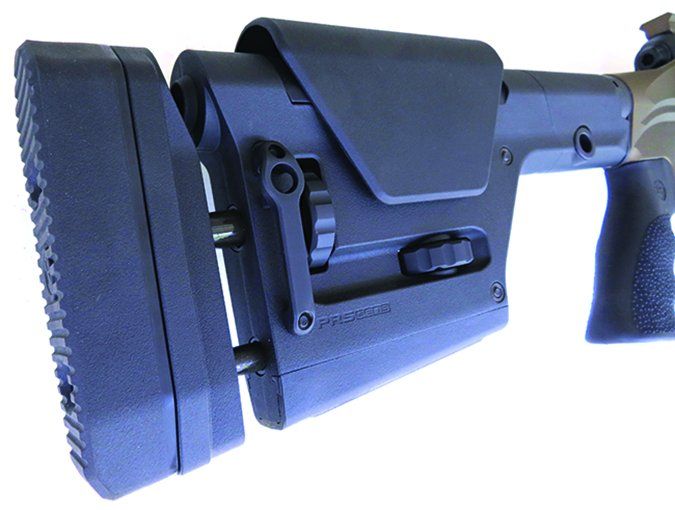
This was a recent posted price from BudsGunShop.com. On the same day, CheaperThanDirt.com listed the same rifle at $1125 and SportsmansOutdoorSuperstore.com priced it at $1155. Consider the Stealth a stripped-down, bare-essential long-range rifle. Savage has taken the 110 barreled action and dropped it into a Drake aluminum chassis. The action and barrel are blueprinted by Savage, so the best accuracy from the components can be achieved. The long action is mated to a heavy-profile fluted barrel with a nice muzzle brake. The safety is a two-position slider operated by a shooter’s thumb — simple and intuitive. Bolt removal requires pressing the trigger and depressing the bolt-release lever on the right side of the action.
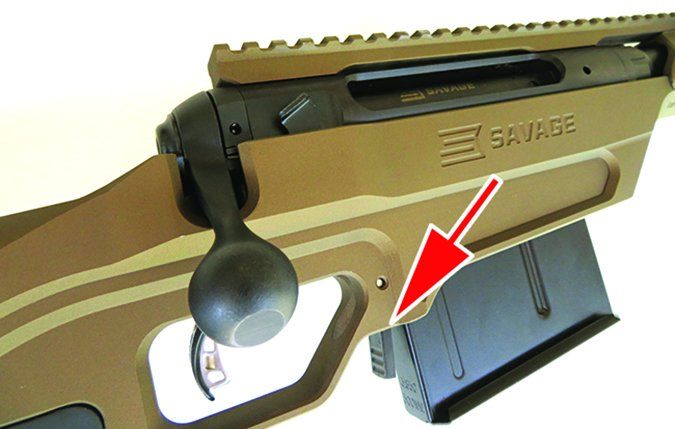
The Stealth comes in a cardboard box with one steel-body single-stack magazine. The double-stack-magazine round capacity in the Steyr and Barrett are nearly double, which we preferred. The chassis wore a burnt bronze finish with a matte-black barrel, action, and magazine. The rifle looked sharp to those who like the bronze look. The rubber pistol grip was a Hogue Overmolded piece. Any AR-style pistol grip or buttstocks will work with the Drake aluminum chassis.
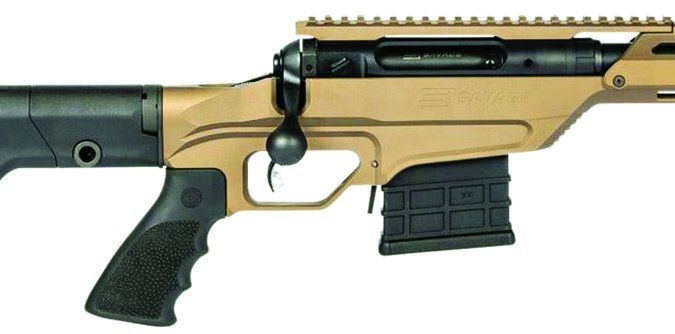
An excellent Magpul PRS was fitted to our sample. This stock is adjustable for length of pull and comb height via wheels that are rotated. A sling swivel stud is attached to the forend. The forend will also accept Picatinny rails at the 3, 6, and 9 o’clock positions. In our opinion, there was plenty of Picatinny rail at the 12 o’clock position to securely mount any size scope.
At first look, the 110 BA Stealth seemed just like a 110 barreled action mated to a Drake aluminum chassis, and we assumed the set up would lag behind the more expensive rifles. Not so. We shot the smallest group in the test with the Stealth. Getting behind the Stealth, the stock comfort was similar to the Barrett. The Stealth was the lightweight of the three rifles. Recoil was a bit more noticeable. The action was not nearly as smooth as the others, but is was good enough for the price discount. It took more movement to crank the Savage’s bolt. Another nit was the magazine rattled in the chassis. The others were silent and secure. While the Stealth features Savage’s excellent AccuTrigger, all the rifles had in common a crisp and adjustable trigger and enlarged trigger guard. Operating the rifles with gloved hands posed no issues.
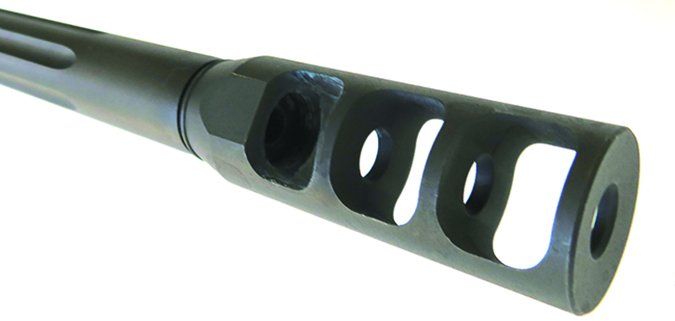
Because all the rifles are push-feed models, the rifles allowed single-loading a cartridge through the ejection port. The ports were similar in size. We liked the large paddle magazine release on the Savage the best. Depress the magazine release paddle, and the magazine would drop free, unlike the Steyr and Barrett magazines, which required the user to strip the magazine. This is not a big deal because speed reloading a long-range rifle is not a requirement.
Our Team Said: The Stealth is an intriguing, low-cost option if you have interest in shooting long range without having to go to the bank. Because the Drake chassis is compatible with AR components, you could swap out stocks and pistol grips if one or both did not suit you. We felt you could outfit the Savage with a more expensive scope, carry case, and ammo and still be under the cost of the Steyr and Barrett. Thus, we call it a Best Buy.
Barrett MRAD 14361 300 Winchester Magnum, $6000
GUN TESTS GRADE: A
Versatility and accuracy best describe the MRAD due to the data we collected and the ability to swap calibers. The design is simple and robust, but the cost is crazy high. The grade above is for the rifle’s utility, without price factored in.

| ACTION TYPE | Bolt, push feed |
| OVERALL LENGTH | 48.75 in. |
| OVERALL LENGTH, FOLDED | 40.75 in. |
| HEIGHT UNBOXED | 8 in. |
| HEIGHT AS TESTED | 11.8 in. |
| WIDTH, STOCK EXTENDED | 3.25 in. |
| WIDTH, STOCK FOLDED | 3.25 in. |
| WEIGHT UNBOXED | 13.25 lbs. |
| WEIGHT, LOADED | 15.3 lbs. |
| WEIGHT, RANGE | 16.2 lbs. |
| BARREL | 24 in. long; 1:10 RH twist, matte-black stainless steel, 2-port muzzle brake |
| STOCK | Aluminum chassis w/ adjustable metal and polymer buttstock; rubber buttpad |
| STOCK LENGTH OF PULL | Adjustable, 5-position |
| STOCK COMB | Straight, adjustable for height |
| STOCK FOREND | Aluminum, slotted |
| STOCK SLING ATTACHMENTS | 2 QD |
| STOCK PISTOL GRIP | Magpul MOE polymer |
| TRIGGER | 2.5 lbs. factory set, adjustable single stage |
| TRIGGER GUARD | Aluminum, enlarged |
| SAFETY | 2-position lever, AR style |
| MAGAZINE | (2) 10-rd. detachable double-stack box, polymer |
| MAGAZINE RELEASE | Ambidextrous paddle, front of trigger guard |
| BOLT | 9-lug, 60-degree lift |
| BOLT RELEASE | Receiver latch |
| SIGHTS | None, Picatinny top rail |
| ACCURACY GUARANTEE | None |
| WARRANTY | 1 year |
| TELEPHONE | (615) 896-2938 |
| WEBSITE | Barrett.net |
| MADE IN | USA |
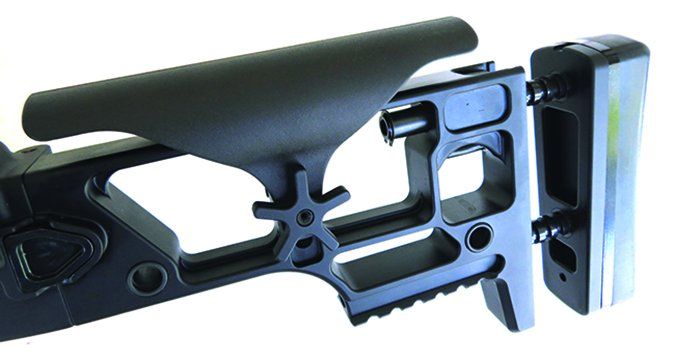
The MRAD was designed for adaptability and configuration at the user level. It offers the ability to swap calibers between 6.5 Creedmoor, 308 Winchester, 300 Win. Mag., and 338 Lapua Magnum. Extra barrels, magazines, and bolt assemblies are required for the caliber transformation. Our sample came in a Pelican case with the foam pre-cut to the hold the scoped rifle with the stock folded, separate slots for the two magazines, and other cubbies for accessories and tools. Our rifle wore a matte-black finish that was well executed.
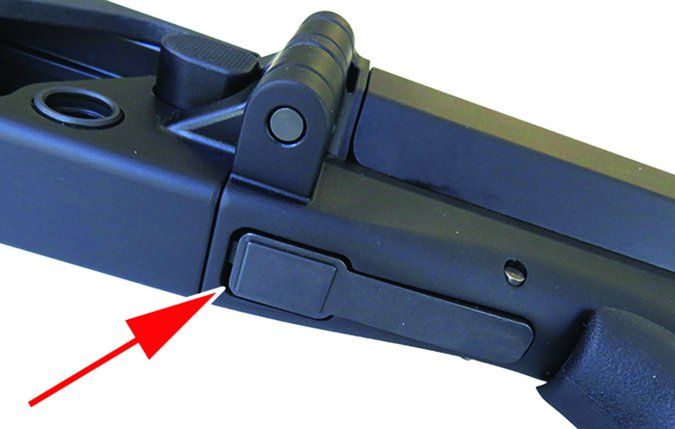
Unlike the Savage and the Steyr, which are traditional bolt-action rifles, the MRAD is designed to mate the upper and lower receivers like on an AR platform. A retaining latch under the stock separates the two receivers on a pivot pin so the bolt assembly can be removed for cleaning. The chassis of the Steyr and Savage allowed the user to jam the mag well up against a barrier, if needed for stability. With the MRAD, you would jam the front of the magazine against the barrier. Not a deal breaker by any means because these rifles are designed to be fired off bipods and tripods.
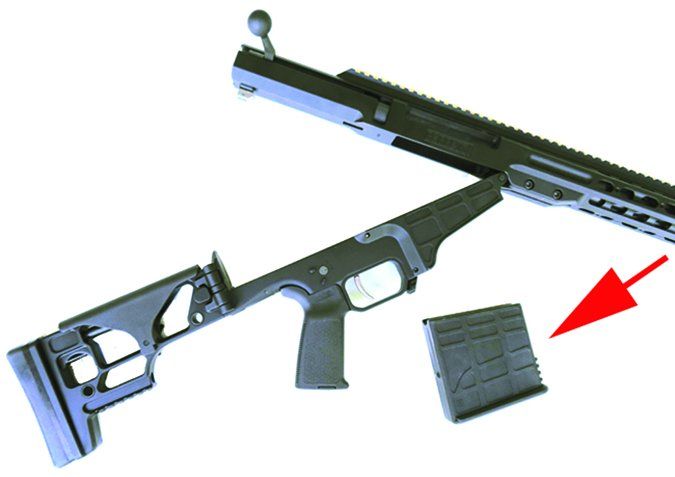
The MRAD was the heaviest of the rifles tested, and that we liked. The upper housed the barrel, which was heavy profile and fluted. Two hex screws secure the barrel to the upper, and when removed, allow the user to swap barrels for a different length or caliber. The muzzle brake, in our opinion, helped mitigate recoil the best. The bolt is encased in a polymer tube, which offered slick lubricity and acted to keep dirt and debris out of the action. A clever design, we thought. The bolt throw was 60 degrees, the smallest in the test, and that allowed us to crank the bolt faster than on the others. The monolithic upper also had plenty of Picatinny rail to mount a massive scope as well as night-vision gear, if needed. The lower housed the trigger group, which is easily removed for cleaning and adjustment. The lower also holds the folding stock and Magpul MOE pistol grip. The grip can be replaced with any aftermarket AR grip.
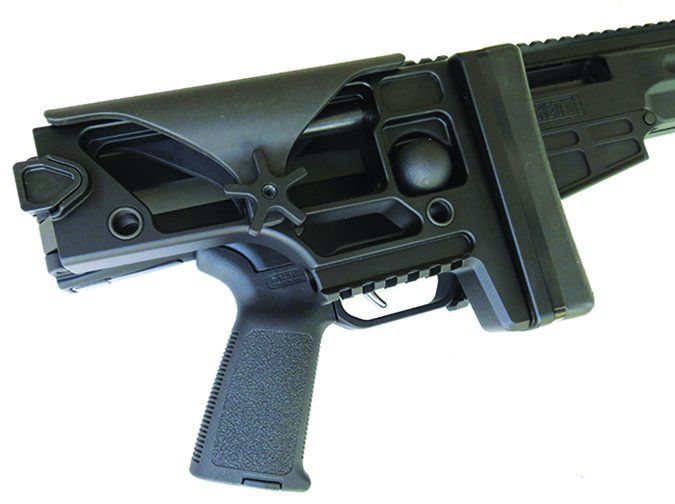
Some testers would ditch the Magpul MOE grip and install an AR grip with a 15-degree grip angle, especially if prone shooting. The safety lever is like an AR platform, rotating between Safe and Fire; it is simple and easily adapted to by AR shooters. The stock is adjustable for LOP via a button that extends or collapses the butt at preset intervals. The comb adjusts for height via a rotating knob. The stock folds to the right and locks the bolt handle — a nice safety feature, we thought. We liked this stock and found it easy to shoot with. We used a sock filled with sand on both the Savage and Barrett to fine-tune the vertical position of the rifle when aiming in tandem with the bipods.
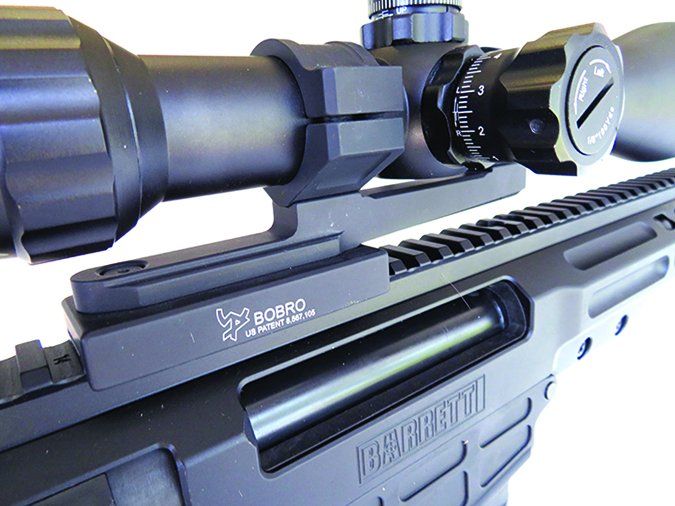
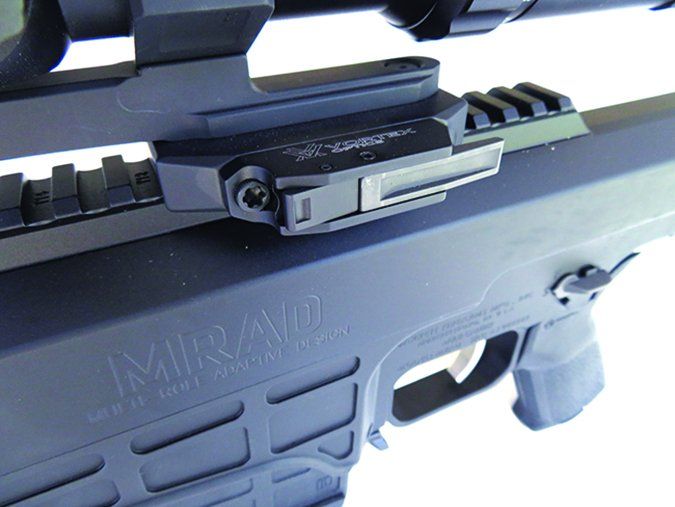
The MRAD bolt rifle uses polymer magazines that were easy to load. At first, the magazines encountered slight resistance when inserted into the mag well, but with use, they slid into and out of the mag well with ease. The magazine release is an ambidextrous paddle that we thought could be slightly larger for better ease of use.
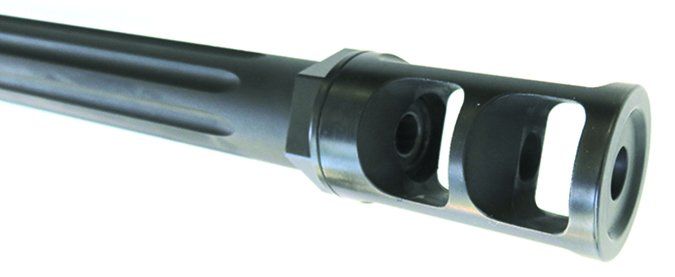
Getting behind the MRAD was a pleasant experience. The safety lever was familiar, the bolt throw was slick, and the muzzle brake allowed us to stay on target for a fast follow-up shot. The MRAD did not toss brass far, which we liked. We believe the overall weight, crisp trigger, and adjustable stock helped us achieve the accuracy listed in the accompanying table.
Our Team Said: We liked the MRAD for its simplicity and its ability to swap out barrels and calibers, which also makes it very expensive. The magazine latch needs to be fitted with a longer paddle for more leverage and better ease of use. If you have plans for long-range shooting in a variety of calibers, this would be a good choice. We did not ding the rifle for its cost.
Steyr SSG 08 6001138 300 Winchester Magnum, $3353
GUN TESTS GRADE: A (Our Pick)
The SSG 08 is a precision instrument with features that make it easy to shoot, like the fully adjustable stock. This is still a lot of money, but the Steyr is a lot of gun.

| ACTION TYPE | Bolt, push feed |
| OVERALL LENGTH | 46.5 in. |
| OVERALL LENGTH, FOLDED | 37.8 in. |
| HEIGHT, UNBOXED | 7.5 in. |
| HEIGHT, RANGE | 11.3 in. |
| WIDTH, STOCK EXTENDED | 3 in. |
| WIDTH, STOCK FOLDED | 5 in. |
| WEIGHT, UNBOXED | 14.4 lbs. |
| WEIGHT, LOADED | 16.5 lbs. |
| WEIGHT, RANGE | 17.2 lbs. |
| BARREL | 23.6 in. long; 1:10 RH twist, matte-black (Mannox) finish, stainless steel |
| BARREL MUZZLE DEVICE | 3-port brake |
| STOCK | Aluminum chassis, metal/polymer buttstock, fully adjustable, rubber buttpad, 0.8 in. thick |
| STOCK LENGTH OF PULL | 14.25 to 14.91 in. adjustable |
| STOCK COMB | Straight, adjustable for height and cant |
| STOCK TOE | Adjustable monopod |
| STOCK FOREND | Aluminum, slotted, bipod attachment |
| STOCK SLING ATTACHMENTS | 2 QD style |
| PISTOL GRIP | Polymer, modular inserts |
| TRIGGER PULL WEIGHT | 3.5 lbs. factory set, adjustable single stage |
| TRIGGER GUARD | Aluminum, enlarged |
| SAFETY | 3-position wheel, tang mounted |
| MAGAZINE | (1) 8-rd. detachable polymer double-stack box |
| MAGAZINE RELEASE | Dual grooved tabs, side of magazine, two-stage |
| BOLT | 2-lug bolt, 70-degree lift |
| BOLT RELEASE | Safety wheel, tang mounted |
| SIGHTS | None, 15.9 in. Picatinny top rail |
| ACCURACY GUARANTEE | Sub-MOA |
| WARRANTY | 1-year |
| TELEPHONE | (205) 417-8644 |
| WEBSITE | SteyrArms.com |
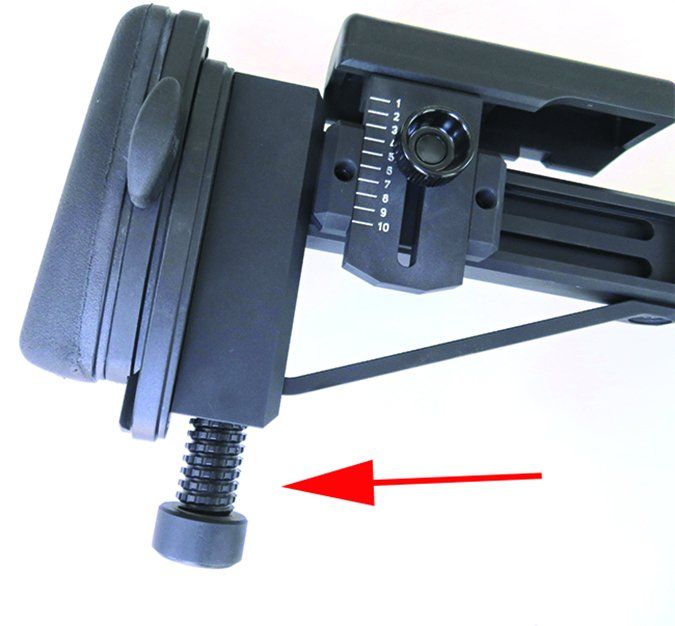
This was a recent price at BudsGunShop.com, but fewer than five were available at that price. The SSG 08 is a refined shooting instrument. It comes in a hard case with foam padding and includes a bipod, one magazine, and pistol grip inserts. The SSG 08 was the only rifle in our test that guaranteed accuracy and included the simulated test target that showed a sub-MOA 3-shot group. Fit and finish were superior, with a unique spiral pattern on the barrel.
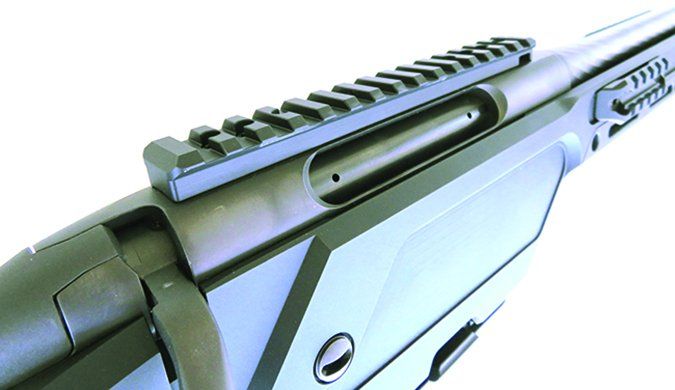
The SSG 08 places a Steyr barreled action in a steel-and-polymer chassis. The forend is set up with Picatinny rails at 3, 6, and 9 o’clock. A pin at the front of the forend allows attachment of the included bipod. We liked the bipod as it had flat feet at the end of the legs, which could be independently adjusted to conform to uneven terrain. We would have liked rubber feet for better friction on surfaces, but that is a nit. The buttstock was adjustable for LOP and comb height. It also had indicator marks on the cheek riser so you could adjust the comb and go back to where it originally was positioned. The cant of the cheek riser could also be adjusted. The LOP could be adjusted by adding or replacing inserts.
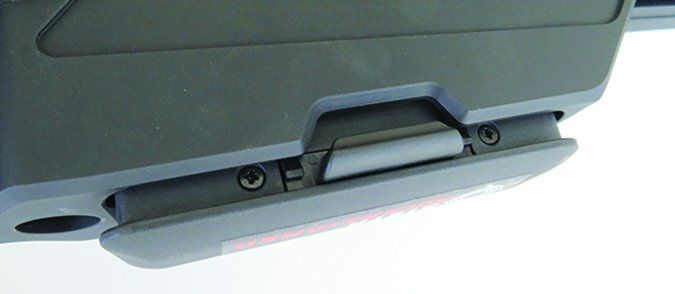
A rubber buttpad gave good adhesion and helped reduce felt recoil. In the toe of the stock was a retractable monopod that could be locked into position, plus the foot of the monopod could be dialed to fine-tune the rifle position. We thought this stock made long-range shooting easier, and our shooters preferred this stock over the others. The stock also folded to the left side of the rifle to decrease the overall length for transportation. With the stock folded, the rifle could still be fired, which might be a consideration for some users. To fold the stock, a user pulls up on the stock and swings it forward. It locks in place when folded, and a good yank on the folded stock extends it and locks it in place. When folded, the Steyr had the thickest width. To remove the bolt, the stock needed to be folded. The pistol grip is modular and has three front and rear grip strap choices, ranging from flat and arched to finger grooves and no finger grooves. We liked the modularity of the grip.
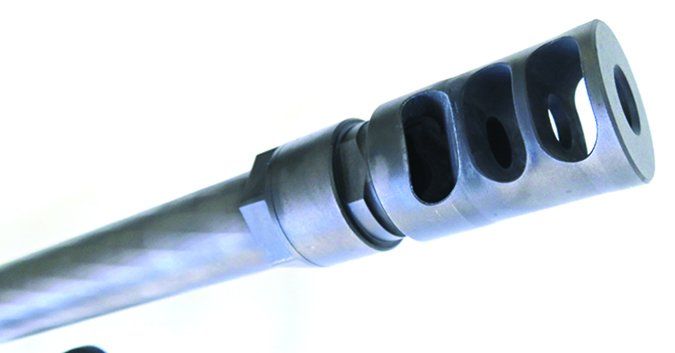
The three-position safety uses a knurled wheel and is operated by the shooter’s thumb. All the way back is the Fire position. The middle position is safe and allows only the bolt to be operated. All the way forward locks the bolt closed and a small button pops up, locking the safety. Push the button down and rotate it to Fire. The safety also acts as the bolt release. Lift the bolt handle, turn the safety until the button pops up, and the bolt can be removed.
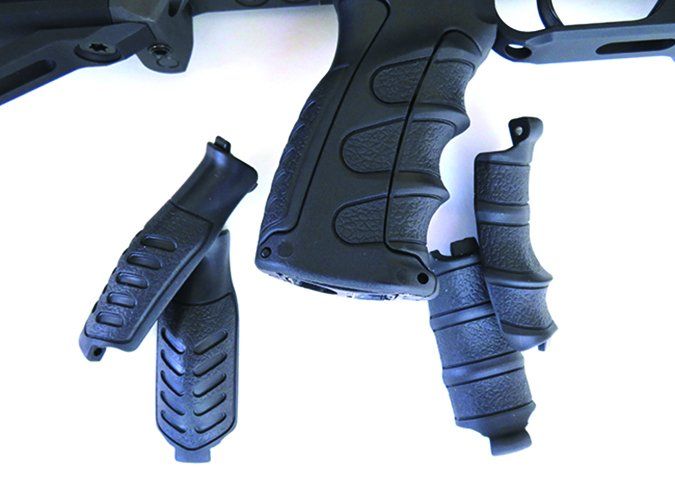
The magazine could also be partially seated so the bolt could eject a round from the chamber and then pushed forward without loading the top round in the magazine. To remove the magazine, the user presses a pair of latches on either side of the magazine. When we seated the magazine, it pinched some tester’s fingers. We did notice the Steyr’s muzzle velocity was noticeably less than the Savage and Barrett.
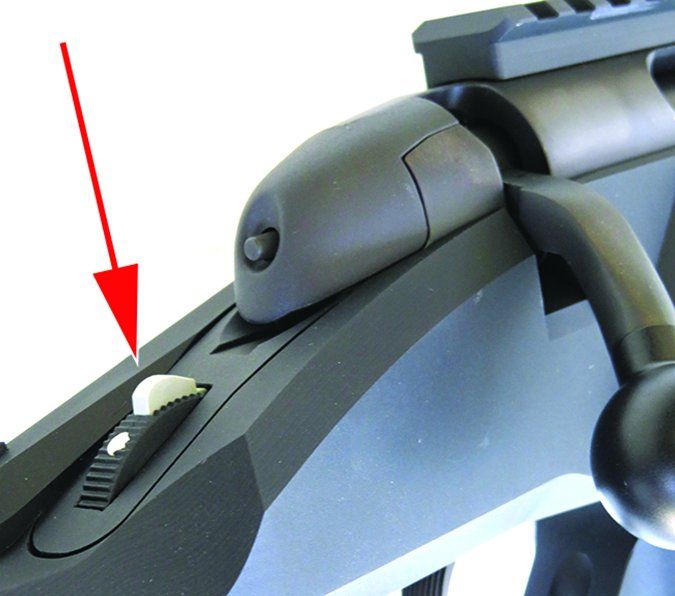
Going hot with the SSG 08, we found users could get in a more comfortable position than with the Savage and Barrett. That was due to the adjustable stock. The action of the SSG 08 was the smoothest of all the rifles, with the Barrett coming in a close second. The Savage was smooth but not as buttery as the others. This was due to polymer sleeves in which the bolts of the Steyr and Barrett rotated. The polymer sleeve made the action slicker than the steel-to-steel bolt of the Savage. The bolt throw was 70 degrees, which was less than the Savage at 90 degrees and more than the Barrett at 60 degrees. The knob is polymer and oversized, and we could work it with speed. The muzzle brake helped control recoil, and we thought it did a good job, though in our opinion the Barrett’s muzzle brake performed the best. The single-stage trigger was crisp and the best of the three.
Our Team Said: The Steyr had the most comfortable and adjustable stock, a slick action, good accuracy, and a crisp trigger. Some testers did not care for the magazine release and complicated safety.
Written and photographed by Robert Sadowski, using evaluations from Gun Tests team testers.

























